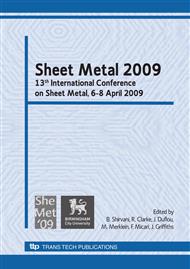[1]
Galakhar, A.S., W.J.T. Daniel, and P.A. Meehan, A method of approximate tool wear analysis in cold roll forming, in 5th Australasian Congress on Applied Mechanics (ACAM 2007), M. Veidt, et al., Editors. 2007, Engineers Australia: Brisbane, Australia. pp.703-708.
Google Scholar
[2]
Halmos, G.T., Roll Forming Handbook, ed. G.T. Halmos. 2006: CRC Press. 584 p.
Google Scholar
[3]
Kato, K., A Basic Study on Cold Forming Technique, in Technical Report Overseas. 1963, Nippon Kokan Kubushiki Kaisha. pp.44-54.
Google Scholar
[4]
Määttä, A., P. Vuoristo, and T. Mäntylä, Friction and adhesion of stainless steel strip against tool steels in unlubricated sliding with high contact load. Tribology International, 2001. 34: pp.779-786.
DOI: 10.1016/s0301-679x(01)00074-3
Google Scholar
[5]
Páczelt, I. and Z. Mróz. Contact optimization problems associated with the wear process. in XXI International Congress of Theoretical and Applied Mechanics (ICTAM 2004). 2004. Warsaw, Poland: Springer Verlag.
Google Scholar
[6]
Piegl, L. and W. Tiller, The NURBS Book. Second ed. Monographs in Visual Communication, ed. D.F. Rogers. 1995, New York: Springer-Verlag.
Google Scholar
[7]
Shaw, M.C., Engineering Problem Solving: A Classical Perspective. 2001, Norwich, New York: Noyes Publications - William Andrew Publishing. 472 p.
Google Scholar
[8]
Suzuki, H., et al., Experimental Investigation on Cold-Roll-Forming Process II: distribution of contact pressure on interface between sheet metal and forming rolls in roll-forming process through tandem mills. 1976, The Institute of Industrial Science, the University of Tokyo: Tokyo. p.56.
Google Scholar


